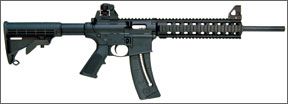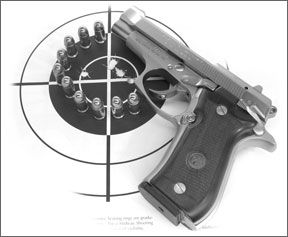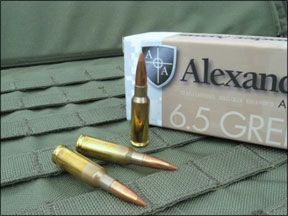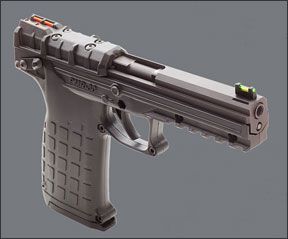Re “Tactical-Style 22 LR Carbines: Ruger, S&W, Legacy Duke It Out,” February 2010 I respect the way Gun Tests conducts its business. I have had an experience that I just had to share with you as it concerns the safety of people that may use your test to select a firearm for younger shooters. After reading your test of the M&P15-22, I was very interested in purchasing one for my son. Luckily, I 288 had an experience at the range this last Sunday that put me off the idea. While at the range, I happened to notice that the guy next to me had a M&P15-22. He was running through ammo as fast as he could load the magazine. Everything seemed to be going well, but after about 200 rounds, I started to be splattered with brass fragments. The chamber obviously was getting dirty and needed to be cleaned. I told the guy I was getting hit by fragments and he stopped using it. I noticed that the shell casings were completely shattered around the rim and forward for half the case length. This indicated that the rounds were going off with the round only half chambered and therefore, not supported. We investigated further and found that due to the dirty chamber, the rounds were not always going completely into the chamber and the bolt (blowback action) was permitting the hammer to strike the firing pin when the bolt was out of battery. I have had some experience in life with the design of blowback autoloaders, and the good ones have some sort of timing mechanism that prevents the firing pin from striking the primer when the bolt is not in battery. Examples of good ones are Winchester Model 77 striker fired with a timing rod that will not allow the sear to release the firing pin unless the bolt is within 1⁄16 inch of full battery. Other examples are the Marlin Model 60 and cousins that are hammer fired that have a similar mechanism built into the trigger system. All of the 22 LR self-loading handguns I have ever inspected are similarily constructed (like a Ruger Mark III). The S&W M&P15-22 does not appear to have this safety mechanism as part of its design. I was able to dry-fire the M&P15-22 with the bolt more than half open, with my finger on the bolt face and feel the firing pin hit my finger. With the bolt half open, the hammer should not have even hit the firing pin, let alone release from the sear. 288 I stopped into a local gun shop to talk to the gunsmith about this, and we pulled several brands of 22 autoloaders from the shelves to see how many had timing mechanisms. All the good brands had something that prevented the striker or hammer from falling unless the bolt was within 1⁄8 inch of full battery, except the Ruger 10/22. The Ruger’s hammer would fall when the bolt was still 1⁄2 inch from battery, but I could not get my finger into the chamber to see if the firing pin was hit. The gunsmith said he was going to do some more tests on this because I may have found the reason he has had some complaints from customers of exploded rims on some 22 LR ammo with the 10/22. I would suggest that you adopt an out-of-battery check on your future tests of unlocked-breach weapons, and report this condition within the evaluation. I have found that all the 22 LR conversions for the AR-15 I have seen also have this defect. I am writing to S&W with my concerns as well. —Charles Sears, I’ve forwarded your note to Smith & Wesson for comment. As soon as we hear back, we’ll report the company’s response. —Todd Woodard How About the Cheetah? Mr. Shaw, I appreciate you sticking around for the last decade. Beretta currently lists an 84-series line and an 85-series lin of Cheetahs in 380 ACP. The 84s have larger magazine capacity, up to 13 rounds. Ray Ordorica tested the 85FS in the April 2006 issue, saying of the gun, “The Beretta .380 was not our first 288 choice as a pure pocket gun, it being much bigger than the other two guns tested. But it did work very well, and might make an ideal gun for those who want one gun for both self protection and occasional plinking.” Roger Eckstine tested the Beretta Cheetah M84 LS 380 Auto, $652, in the November 2002 issue and named it an Our Pick. He wrote, “This was an easier to handle and easier to hide version of Beretta’s signature pistol, the Model 92. While the 380 was not a big stopper, the Cheetah was still a higher capacity option with more class and charm than heavier recoiling plastic guns.” —tw Value Guides Valuable Your “Value Guides” on various categories, such as the one on autoloading rimfire rifles found in the February 2010 edition, are terrific! Very useful in assisting my purchasing decisions. Thanks for compiling the guides. —Mark Flusche, Let’s give credit where credit is due. Gun Tests readers have asked us to test more guns per feature. But because of space restrictions, including more than three to four guns per feature consumes too many pages and makes someone unhappy. See John Lamkin’s letter in the May 2009 Firing Line. We thought unlocking the archives for subscribers would solve the back-test problem—basically, now everyone has the same access to the archives that I do. As it turns out, though, compiling the back-test information into a Value Guide saves everyone the four hours needed to research multiple tests and compile them. So I’m glad they are of use. —tw 6.5 Grendel Tests, Please I’m very interested in the 6.5 Grendel round. Unfortunately, there aren’t very many rifle manufacturers that make rifles in this caliber. Les Baer, Sabre Defence, and Alexander Arms do. I would very much like to see a comparative test done on these three, and or any other 6.5 Grendel rifles that I may not have known about. The 6.5 Grendel rifle from Sabre Defense starts at $1599. Alexander Arms’s version starts at $1200, and Les Baer is over $2000. —Tony Ford Grendel is a monster that terrorizes Danes in the novel Beowulf. Not a lot of rounds have a literary background, so that alone makes it interesting. The website www.65grendel.com covers the development of the round pretty well. John Hanka, creator of www.65Grendel.com, says, “The 6.5 Grendel is an evolution of the 6.5 PPC, first created by Dr. Lou Palmisano when he developed his famous 22 PPC and 6 PPC.” We’ve tested midrange cartridges in the AR 288 platform previously (January 2009, “6.8 SPC AR-15 Carbines: The Stag Arms 5L Gets the Nod,” so we’re not averse to the topic. I’ll see about getting some guns together. —tw Yes, Yes We Can —David Spry We have a Five-seveN in house and I will turn the dogs loose on the PMR30. I appreciate the tip. Roger Eckstine has tested the Five-seveN previously, in the March 2005 issue. Bottom Line: “FN Five Seven Pistol 5.7x28mm, $1020. Buy It. We’re not entirely settled on the fight-stopping capability of the civilian issue 5.7x28mm ball ammunition, but we feel FN did an excellent job of bringing together design features such as a fine trigger, manual safety, a first-class accessory rail, ease of maintenance, and foolproof accuracy in an ultra-lightweight package.” —tw How About Cleaners and Lubricators? Can you test gun-cleaning and lubricating products for what they claim and how effective they are? I think this would be very helpful and believe that you are one of the very few trusted sources that can do it in an unbiased way. —J Bean Ray Ordorica covered bore cleaners in the February 2005 issue, “Getting Bores Clean: Copper Solvents Require Elbow Grease.” Results: Montana X-treme 50 BMG Copper Remover ($8.50 for 4 ounces). Our Pick. Sweet’s 7.62 Solvent ($8.79 for 200ml or 6.7 ounces). Buy It. Accubore ($6.95 for 100ml, or 3.4 ounces); Shooter’s Choice Copper Remover ($9.61 for 8 ounces); Sports Care Copper Cleaning Gel ($8.95 for 4 ounces); and Tetra-Gun Copper Solvent ($6.99 for 4 ounces). Conditional Buys. Ray covered lubricants in the July 2000 article, “Gun Maintenance Checkup: We Pick Seven Slick Rust Preventives.” Results: “The winners were Break-Free CLP, Du-Lite’s Kwikseal, Ox-Yoke’s Wonder-Lube 1000 Plus, Boeshield T-9, Shooter’s Choice Rust Prevent, Brownells Rust Preventive No. 2, and RIG Universal Grease. We couldn’t see a major difference in any of these.… Of the winners, the only one which was touted to do it all, including cleaning, lubricating, and rust-preventing, was Break-Free CLP….” —tw Re “Kimber, CZ Compete: 22 LR Conversions for Centerfire Guns,” February 2010 Ray Ordorica indicated he intended to test some more 22 LR conversions, including Ciener. Based on my experience, you might have a long, long wait for any Ciener products. I placed an order for one of their AK-47 22 conversion kits in early December 2007. My checked cleared my bank on Dec. 17, 2007. I’ve not yet received the conversion kit! Their website indicated 30- to 120-day delivery—the 120 days passed long ago! I’ve tried to call their office and I’ve sent emails and certified letters. No response! Checked out their website to try the Warranty Service link—it was a blank page. Tried to call them, but the voicemail goes to “full inbox.” In the past I’ve call them and found them helpful. But not any more! Suggest you test an Advantage Arms 22 conversion for your Glock. I’ve got one, and it works great. I love 22 conversion kits; I’ve got 22 conversions for my AR, Glock, 1911, Sig, Beretta 92, Hi-Power; even one for my P-38! I recall having had a hard time contacting Ciener. In the past I could simply phone ‘em. Bottom line, I got a message through and in fact have the Hi-Power unit in hand. I vaguely recall leaving a phone message, maybe an email, with my number, and got a call back promptly. —Ray Ordorica

Mount Vernon, Washington
—Raymond E. Shaw,
Merriam, Kansas 
Fort Sill, Oklahoma
—Jim Bulkeley,
Sandy, Utah



























